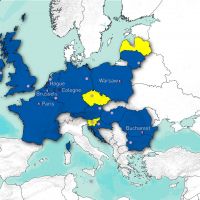
- Author: CESCI
- Territory: Carpathian space
- Year of publication: 2020
- Type: Programming document
- Language: English
- Number of pages: 286
Territorial analysis of the programme area of the next Hungary-Slovakia Interreg CBC Programme
In the summer of 2019 CESCI was commissioned by the Ministry of Foreign Affairs and Trade as Managing Authority to start the thematic preparation of two future cross-border programmes for the period of 2021-2027. One of these is the Slovakia-Hungary INTERREG Cross-Border Cooperation Programme and the other is the Hungary-Serbia INTERREG IPA Cross-Border Cooperation Programme. The team of CESCI started the thematic preparation of the two programmes according to a similar methodology and schedule.
In August 2019 an online questionnaire was distributed among the territorial stakeholders to investigate their opinion about the importance of certain topics having cross-border relevance, and to provide them with the opportunity to present their already emerging project ideas. Nearly three hundred people from the Hungarian-Slovak border region filled in the questionnaire. After the survey was completed, at the beginning of September, regional workshops were organised in the border region, where, with the application of interactive methods, the affected territorial actors were invited to rank the most relevant topics. In parallel with the fieldwork, CESCI has prepared a detailed territorial analysis of the border area.
At its meeting held on 6 November 2019, the Programming Committee of the Slovakia-Hungary INTERREG Cross-border Cooperation Programme made a resolution on the way of continuation of the work. For three themes (Heritage Management, Economic Development, Societal Challenges), the Committee considered that further analyses were needed, while two themes (Institutional Cooperation, Environmental Sustainability) were proposed to be considered horizontal instruments. In parallel with the analytical works, CESCI intended to organise three sectorial workshops on both sides of the border on the above topics, however, due to the epidemiological situation, only the workshops on the Hungarian side were realised. For this reason, it was necessary to modify the original methodology and the schedule, and prepare bilingual extracts of the territorial analysis that the regional stakeholders could comment online (in writing or in the form of a webinar). Each of the six webinars was attended by 25-30 territorial experts who commented on the main findings of the analysis, however, also written comments were welcomed that were incorporated into the final version of the analysis.
Following the meeting of the Programming Committee held in Dudince, Slovakia, in August 2020, the comments were embedded in the territorial analysis in September and the document was sent to the Managing Authority. In parallel, the preparation of the programme has entered the next stage, about which more information can be found on the programme page, where also the territorial analysis is available.




